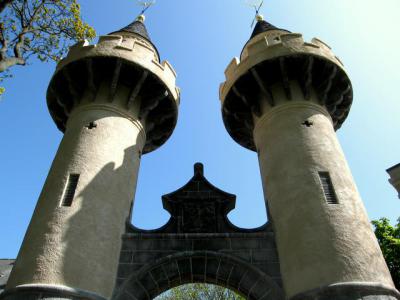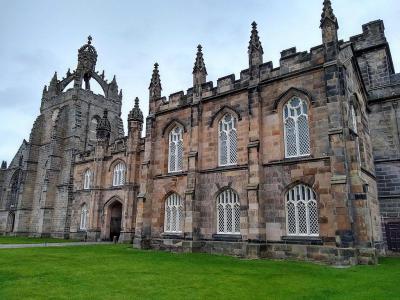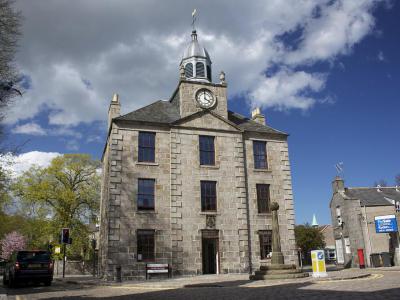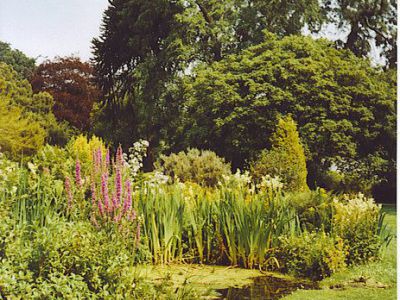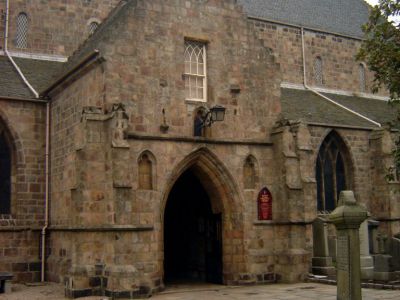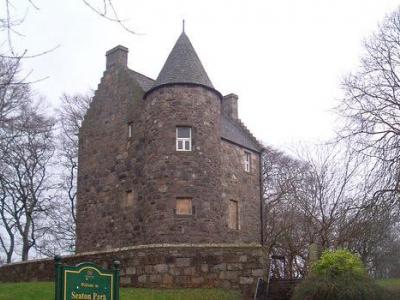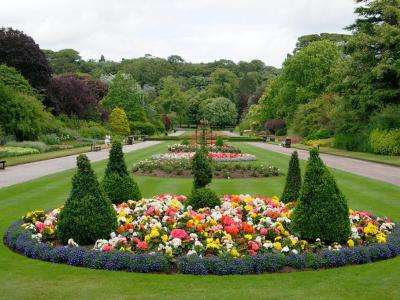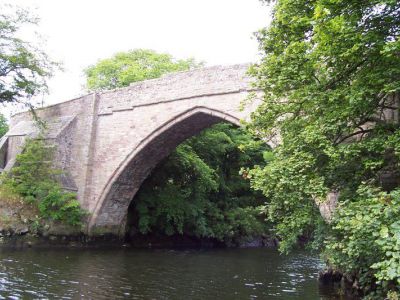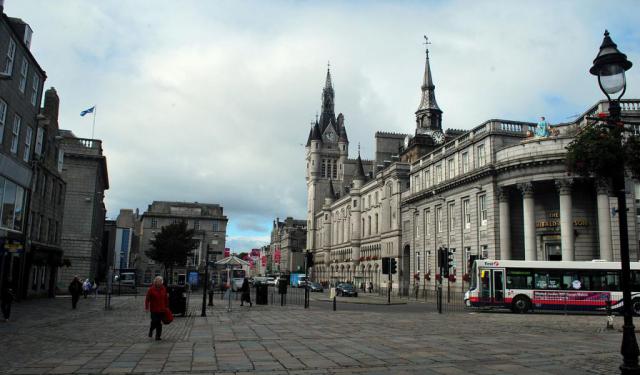Aberdeen Old Town Tour (Self Guided), Aberdeen
Established in 1489 as a separate burgh, Old Aberdeen was an important political, ecclesiastical and cultural center since the late Middle Ages. The locality merged with the rest of Aberdeen only in 1891. Today, the central part of the Old Town is a conservation area, characterized by well-preserved medieval dwellings and many other unique, vernacular structures of the 17th-early 19th centuries, built in the locally ubiquitous grey granite.
Old Aberdeen is effectively the main campus of the University of Aberdeen. To the north of it stands St Machar's Cathedral, whose ecclesiastical buildings formed the original Old Aberdeen before the University arrived in 1495.
A historic landmark in its own right, King's College is a true architectural monument, dominating Old Aberdeen and comprising, among other highlights, the iconic late 15th-century King's College Chapel. Arguably, this is the most recognizable building on the university campus and one of the two surviving Scottish medieval churches with open "crown" spires. Just south of King's College lie the Powis Gates, an impressive and imposing archway with a Near Eastern influence demonstrated in its 'minaret' towers.
Among other major draws in the area are the recently restored (early 18th-century) Old Town House – an ideal example of Scottish architecture, currently home to King's Museum; the Cruickshank Botanic Gardens – a gift to the University of Aberdeen from 1898; and the Wallace Tower – an early 17th-century building originally constructed in the center of Aberdeen, but then moved, stone by stone, to Seaton Park in the 1960s.
To explore these and other notable locations and discover the beauty of Aberdeen's Old Town, take this self-guided walking tour.
Old Aberdeen is effectively the main campus of the University of Aberdeen. To the north of it stands St Machar's Cathedral, whose ecclesiastical buildings formed the original Old Aberdeen before the University arrived in 1495.
A historic landmark in its own right, King's College is a true architectural monument, dominating Old Aberdeen and comprising, among other highlights, the iconic late 15th-century King's College Chapel. Arguably, this is the most recognizable building on the university campus and one of the two surviving Scottish medieval churches with open "crown" spires. Just south of King's College lie the Powis Gates, an impressive and imposing archway with a Near Eastern influence demonstrated in its 'minaret' towers.
Among other major draws in the area are the recently restored (early 18th-century) Old Town House – an ideal example of Scottish architecture, currently home to King's Museum; the Cruickshank Botanic Gardens – a gift to the University of Aberdeen from 1898; and the Wallace Tower – an early 17th-century building originally constructed in the center of Aberdeen, but then moved, stone by stone, to Seaton Park in the 1960s.
To explore these and other notable locations and discover the beauty of Aberdeen's Old Town, take this self-guided walking tour.
How it works: Download the app "GPSmyCity: Walks in 1K+ Cities" from Apple App Store or Google Play Store to your mobile phone or tablet. The app turns your mobile device into a personal tour guide and its built-in GPS navigation functions guide you from one tour stop to next. The app works offline, so no data plan is needed when traveling abroad.
Aberdeen Old Town Tour Map
Guide Name: Aberdeen Old Town Tour
Guide Location: Scotland » Aberdeen (See other walking tours in Aberdeen)
Guide Type: Self-guided Walking Tour (Sightseeing)
# of Attractions: 8
Tour Duration: 2 Hour(s)
Travel Distance: 3.1 Km or 1.9 Miles
Author: jenny
Sight(s) Featured in This Guide:
Guide Location: Scotland » Aberdeen (See other walking tours in Aberdeen)
Guide Type: Self-guided Walking Tour (Sightseeing)
# of Attractions: 8
Tour Duration: 2 Hour(s)
Travel Distance: 3.1 Km or 1.9 Miles
Author: jenny
Sight(s) Featured in This Guide:
- Powis Gates
- King's College Chapel
- Old Town House
- Cruickshank Botanic Gardens
- St. Machar's Cathedral
- Wallace Tower
- Seaton Park
- Brig o' Balgownie
1) Powis Gates
The Powis Gates, located in Old Aberdeen on the grounds of the University of Aberdeen's King’s College campus, are a prominent 19th-century landmark. Designed by Alexander Fraser in 1833-34 for Hugh Fraser Leslie of Powis, a Scottish landowner with ties to Jamaican coffee plantations, the gates served as the grand entrance to Powis House. The structure features two cylindrical towers topped with conical slate caps, golden orbs, and crescent finials, reminiscent of Turkish-style minarets.
The Powis Gates were built during the same period as the Slavery Abolition Act (1833), and it is believed that the wealth used to construct them came from compensation received for the freedom of slaves on the Leslie family's Jamaican plantations. Debate persists about certain imagery on the towers, with some interpreting the shield as depicting enslaved figures, while others argue they are exotic heads from a family coat of arms.
In 2007, the University of Aberdeen undertook a significant restoration of the gates, preserving their architectural and historical significance. Today, the gates stand as a unique monument within the university’s campus, a blend of romantic folly and controversial legacy, symbolizing both the architectural grandeur and the complex history of their time.
The Powis Gates were built during the same period as the Slavery Abolition Act (1833), and it is believed that the wealth used to construct them came from compensation received for the freedom of slaves on the Leslie family's Jamaican plantations. Debate persists about certain imagery on the towers, with some interpreting the shield as depicting enslaved figures, while others argue they are exotic heads from a family coat of arms.
In 2007, the University of Aberdeen undertook a significant restoration of the gates, preserving their architectural and historical significance. Today, the gates stand as a unique monument within the university’s campus, a blend of romantic folly and controversial legacy, symbolizing both the architectural grandeur and the complex history of their time.
2) King's College Chapel
The King’s College Chapel in Aberdeen is a central part of the University of Aberdeen's historical landscape. Founded in 1495 as the University and King’s College of Aberdeen, this formerly independent institution is now a key part of the University of Aberdeen, with its most iconic structure being the late 15th-century King's College Chapel. Situated in Old Aberdeen, this chapel stands as the focal point of the King’s College campus, with its construction beginning in 1498 and concluding with its consecration in 1509.
The chapel’s most remarkable feature is its Crown Tower, a distinctive architectural element that has become symbolic of the university itself. The chapel is dedicated to the Trinity and the Blessed Virgin Mary, with its name also paying tribute to King James IV of Scotland, the institution’s principal patron. Inside, the chapel holds one of the most complete medieval church interiors in Scotland, notably featuring 16th-century choir stalls and a rood screen dating from around 1509.
Serving as more than just a place of worship, since 1928, the ante-chapel has acted as a war memorial for the university, commemorating 524 students who lost their lives in the First and Second World Wars. The chapel also holds historical significance as the burial site of the college’s founder, Bishop Elphinstone, and its first principal, Hector Boece, although the exact location of Elphinstone’s body remains a mystery. The chapel’s design, inspired by Solomon’s Temple, gives it a unique place in both religious and academic history.
The chapel’s most remarkable feature is its Crown Tower, a distinctive architectural element that has become symbolic of the university itself. The chapel is dedicated to the Trinity and the Blessed Virgin Mary, with its name also paying tribute to King James IV of Scotland, the institution’s principal patron. Inside, the chapel holds one of the most complete medieval church interiors in Scotland, notably featuring 16th-century choir stalls and a rood screen dating from around 1509.
Serving as more than just a place of worship, since 1928, the ante-chapel has acted as a war memorial for the university, commemorating 524 students who lost their lives in the First and Second World Wars. The chapel also holds historical significance as the burial site of the college’s founder, Bishop Elphinstone, and its first principal, Hector Boece, although the exact location of Elphinstone’s body remains a mystery. The chapel’s design, inspired by Solomon’s Temple, gives it a unique place in both religious and academic history.
3) Old Town House
The Old Town House in Aberdeen, Scotland, is a historic municipal building located on the High Street in Old Aberdeen. Originally built to serve as the meeting place for the burgh council, the structure is now home to the King's Museum and holds Category A listed status due to its architectural and historical significance.
In the early 17th century, the burgh council met in a small room above Saint Machar's Cathedral. As this arrangement became insufficient, a dedicated townhouse was commissioned and constructed in 1642. This initial building served multiple purposes: a school and a weigh-house on the ground floor, while the first floor housed the council chamber. In 1702, the structure was expanded to include prison cells and a clock tower.
By the 1780s, the building had fallen into disrepair, and in 1788 construction began on a new townhouse designed by local architect George Jaffrey. The completed Georgian-style structure featured a symmetrical granite façade with three bays, a central doorway, and sash windows on each level. The clock tower, crowned by a belfry, incorporated a bell cast in 1754 by John Mowat, a relic from the previous building.
The Old Town House remained the council's meeting place until 1891 when Old Aberdeen was annexed by the City of Aberdeen. Subsequently, the building served various community roles, including as a school and later as a library. In 2001, the University of Aberdeen acquired the building, and following renovations supported by the Heritage Lottery Fund, the structure was refurbished. The King's Museum moved into the Old Town House in 2013, showcasing a collection of artifacts originally assembled at King's College dating back to 1727.
In the early 17th century, the burgh council met in a small room above Saint Machar's Cathedral. As this arrangement became insufficient, a dedicated townhouse was commissioned and constructed in 1642. This initial building served multiple purposes: a school and a weigh-house on the ground floor, while the first floor housed the council chamber. In 1702, the structure was expanded to include prison cells and a clock tower.
By the 1780s, the building had fallen into disrepair, and in 1788 construction began on a new townhouse designed by local architect George Jaffrey. The completed Georgian-style structure featured a symmetrical granite façade with three bays, a central doorway, and sash windows on each level. The clock tower, crowned by a belfry, incorporated a bell cast in 1754 by John Mowat, a relic from the previous building.
The Old Town House remained the council's meeting place until 1891 when Old Aberdeen was annexed by the City of Aberdeen. Subsequently, the building served various community roles, including as a school and later as a library. In 2001, the University of Aberdeen acquired the building, and following renovations supported by the Heritage Lottery Fund, the structure was refurbished. The King's Museum moved into the Old Town House in 2013, showcasing a collection of artifacts originally assembled at King's College dating back to 1727.
4) Cruickshank Botanic Gardens
The Cruickshank Botanic Gardens were built by Anne Cruickshank in 1898. The land was dedicated to Cruickshank's brother Dr. Alexander Cruickshank. It was then given in part to the University of Aberdeen.
The botanic gardens are located on 11 acres on the King's College campus of the University of Aberdeen. The low-lying land is about one mile from the North Sea. The gardens consist shrubs, a rock and water garden, a sunken garden, a rose garden and an arboretum.
The botanic gardens are owned and supported by the University of Aberdeen, the Cruickshank Botanic Gardens Trust and the Friends of the Cruickshank Botanic Garden. Botany students at the university work in the gardens, which are used for teaching, research and public use.
The Cruickshank Botanic Gardens are open year-round. There is no charge for entry to the garden. All tours are self-guided except for those scheduled in advance for groups of 10 or more.
The botanic gardens are located on 11 acres on the King's College campus of the University of Aberdeen. The low-lying land is about one mile from the North Sea. The gardens consist shrubs, a rock and water garden, a sunken garden, a rose garden and an arboretum.
The botanic gardens are owned and supported by the University of Aberdeen, the Cruickshank Botanic Gardens Trust and the Friends of the Cruickshank Botanic Garden. Botany students at the university work in the gardens, which are used for teaching, research and public use.
The Cruickshank Botanic Gardens are open year-round. There is no charge for entry to the garden. All tours are self-guided except for those scheduled in advance for groups of 10 or more.
5) St. Machar's Cathedral (must see)
Saint Machar's Cathedral, sometimes called Old Machar, is a Church of Scotland church. The church is named in honor of Saint Machar who was said to have accompanied Saint Columba on his travel to Iona. The legend states that, on this journey, God told Machar to establish a church at the River Don. Saint Machar is said to have founded the church in the year 580.
A cathedral was built on this site in 1131. It was replaced in 1290 with the current Early English style building. Work continued on the cathedral for more than 150 years before it was fully functional. During that time, a quarter of Sir William Wallace's remains were interred in the walls of the cathedral. The church was finally completed in 1530.
Visitors to the church will find a stone interior with massive gothic archways. There are multiple stained glass windows throughout the church with dates that range from 1870s to 1970s. The Sanctuary Cross in the south aisle is a conglomerate from a 21st century shaft and a 12th century head. The Barbour Tryptich, made from wood, was created by Roland Fraser in 1997.
The three effigies are some of the most striking features of the church. These effigies represent three clerics that date to the 1400s. They were previously held outside of the church but were moved to the interior during one of the many restoration projects.
A number of notable Scottish individuals have been interred on the church grounds and inside the building itself. Along with William Wallace, some of these burials include John Joy Bell, James Edward Crombie, George Dickie and David Gill.
Why You Should Visit:
See the beautiful stained glass cathedral, enjoy the English and gothic architecture, and pay respects to some of Scotland's most notable individuals.
A cathedral was built on this site in 1131. It was replaced in 1290 with the current Early English style building. Work continued on the cathedral for more than 150 years before it was fully functional. During that time, a quarter of Sir William Wallace's remains were interred in the walls of the cathedral. The church was finally completed in 1530.
Visitors to the church will find a stone interior with massive gothic archways. There are multiple stained glass windows throughout the church with dates that range from 1870s to 1970s. The Sanctuary Cross in the south aisle is a conglomerate from a 21st century shaft and a 12th century head. The Barbour Tryptich, made from wood, was created by Roland Fraser in 1997.
The three effigies are some of the most striking features of the church. These effigies represent three clerics that date to the 1400s. They were previously held outside of the church but were moved to the interior during one of the many restoration projects.
A number of notable Scottish individuals have been interred on the church grounds and inside the building itself. Along with William Wallace, some of these burials include John Joy Bell, James Edward Crombie, George Dickie and David Gill.
Why You Should Visit:
See the beautiful stained glass cathedral, enjoy the English and gothic architecture, and pay respects to some of Scotland's most notable individuals.
6) Wallace Tower
Wallace Tower, sometimes referred to as Benholm's Lodgings, is an early 17th-century building located at the southern edge of Seaton Park. It was originally constructed in the center of Aberdeen. It was moved one stone at a time and rebuilt in Seaton Park in the 1960s.
The tower was built by Sir Robert Keith of Benholm. It was later bought by the Duns of Tarty, and then Abernethy. It eventually became a pub until, in a controversial move, retailer Marks & Spencer sought to relocate the tower so that their retail store could be expanded.
The move was a difficult one for Marks & Spencer. The interior of the building had rotted wood that could not be moved and was therefore burned. Likewise, the city worried that anyone who leased the building would attempt to purchase it under right-to-buy laws. Therefore, though the tower was moved, it has remained unused and boarded up.
Those who wish to see the Wallace Tower can do so by going to Seaton Park. The park is open 24 hours.
The tower was built by Sir Robert Keith of Benholm. It was later bought by the Duns of Tarty, and then Abernethy. It eventually became a pub until, in a controversial move, retailer Marks & Spencer sought to relocate the tower so that their retail store could be expanded.
The move was a difficult one for Marks & Spencer. The interior of the building had rotted wood that could not be moved and was therefore burned. Likewise, the city worried that anyone who leased the building would attempt to purchase it under right-to-buy laws. Therefore, though the tower was moved, it has remained unused and boarded up.
Those who wish to see the Wallace Tower can do so by going to Seaton Park. The park is open 24 hours.
7) Seaton Park
Seaton Park, one of Aberdeen’s largest public parks, sits in the Old Aberdeen area, rich in both history and nature. Purchased by the city in 1947, the park was once part of the Seaton House estate, which had been in the Hay family for generations. Major Malcolm Vivian Hay, a cryptographer and historian, sold the land, and though the house itself is now gone-burnt down in 1963-the park remains a cherished public space.
The River Don flows along the park’s edge, with paths tracing both banks, offering scenic walks. The park’s well-maintained flower beds, running along the central pathway, are replanted annually, providing a bright contrast to the surrounding greenery. Nestled within the grounds are secluded walled gardens near Seaton Stables, offering a peaceful retreat. However, due to its low-lying nature, the park is prone to flooding, leading to the creation of a wetland area in 2016, which now supports local wildlife.
Seaton Park holds historical treasures such as the Wallace Tower, a 17th-century structure that was relocated here in the 1960s, and a Bronze Age motte. Students from the nearby University of Aberdeen frequently traverse the park en route to Hillhead Halls of Residence, passing through Cathedral Walk, where vibrant rose and herbaceous beds lead to the iconic Saint Machar’s Cathedral.
One of the park’s most beloved features is "Mr Therm," a 1947 locomotive that once served the Aberdeen Gas Works. Now a fixture in the children’s playground, the steam engine has delighted generations and was refurbished in 2017.
With its blend of historical landmarks, lush gardens, and connections to Aberdeen’s academic life, Seaton Park remains a vital part of the city’s landscape.
The River Don flows along the park’s edge, with paths tracing both banks, offering scenic walks. The park’s well-maintained flower beds, running along the central pathway, are replanted annually, providing a bright contrast to the surrounding greenery. Nestled within the grounds are secluded walled gardens near Seaton Stables, offering a peaceful retreat. However, due to its low-lying nature, the park is prone to flooding, leading to the creation of a wetland area in 2016, which now supports local wildlife.
Seaton Park holds historical treasures such as the Wallace Tower, a 17th-century structure that was relocated here in the 1960s, and a Bronze Age motte. Students from the nearby University of Aberdeen frequently traverse the park en route to Hillhead Halls of Residence, passing through Cathedral Walk, where vibrant rose and herbaceous beds lead to the iconic Saint Machar’s Cathedral.
One of the park’s most beloved features is "Mr Therm," a 1947 locomotive that once served the Aberdeen Gas Works. Now a fixture in the children’s playground, the steam engine has delighted generations and was refurbished in 2017.
With its blend of historical landmarks, lush gardens, and connections to Aberdeen’s academic life, Seaton Park remains a vital part of the city’s landscape.
8) Brig o' Balgownie
The Brig o' Balgownie is a 13th century bridge over the River Don. Made from granite and sandstone at the likely behest of Robert the Bruce, Scottish King from 1306 to 1329. Some say it was commissioned by Bishop Henry Cheyne. Neither the exact year nor the designing engineer of the bridge are known.
The Gothic diamond arch style of the bridge has caused some to believe it was designed by Richard Cementarius. This is probably due to a design that is similar to that of Drum Castle, which is also said to be a Cementarius work. The bridge 39 feet long with an arch that is 56 feet above the water line.
The bridge was originally called the Bridge of Don. It is unknown exactly where the name Balgownie originated. There is consensus that it is based on the local barony, which was probably called Palgoueny or Polgowny.
Visitors should plan to cross the bridge as part of their Aberdeen visit, but they should also look for a distant spot from which they can admire the Brig o' Balgownie and the picturesque River Don.
The Gothic diamond arch style of the bridge has caused some to believe it was designed by Richard Cementarius. This is probably due to a design that is similar to that of Drum Castle, which is also said to be a Cementarius work. The bridge 39 feet long with an arch that is 56 feet above the water line.
The bridge was originally called the Bridge of Don. It is unknown exactly where the name Balgownie originated. There is consensus that it is based on the local barony, which was probably called Palgoueny or Polgowny.
Visitors should plan to cross the bridge as part of their Aberdeen visit, but they should also look for a distant spot from which they can admire the Brig o' Balgownie and the picturesque River Don.
Walking Tours in Aberdeen, Scotland
Create Your Own Walk in Aberdeen
Creating your own self-guided walk in Aberdeen is easy and fun. Choose the city attractions that you want to see and a walk route map will be created just for you. You can even set your hotel as the start point of the walk.
Aberdeen Introduction Walking Tour
The area where Aberdeen now sits has been inhabited by people for at least 8,000 years. The city that we now know as Aberdeen was first chartered in 1179. It was granted city status in 1891.
The city has been successful over the years due to vast granite deposits used for making sturdy buildings and fortifications. It was also known for its fishing, textile and paper-making industries. However,... view more
Tour Duration: 2 Hour(s)
Travel Distance: 2.4 Km or 1.5 Miles
The city has been successful over the years due to vast granite deposits used for making sturdy buildings and fortifications. It was also known for its fishing, textile and paper-making industries. However,... view more
Tour Duration: 2 Hour(s)
Travel Distance: 2.4 Km or 1.5 Miles
The Most Popular Cities
/ view all



